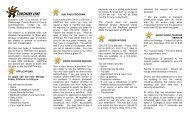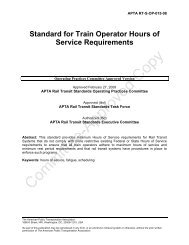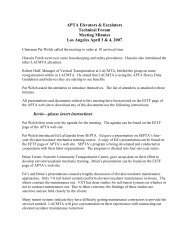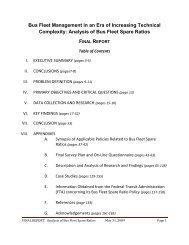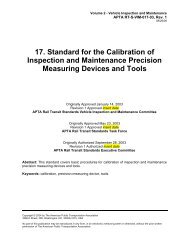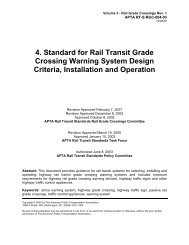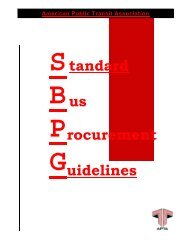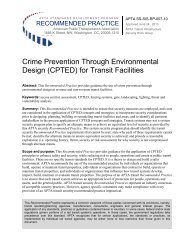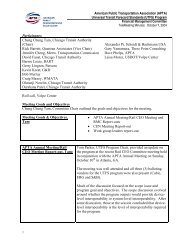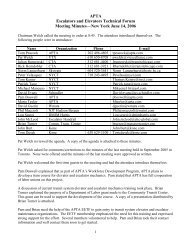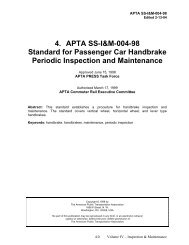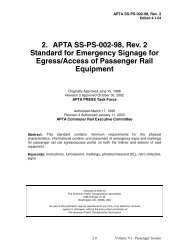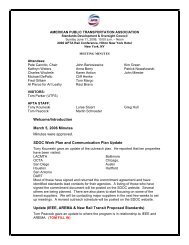4. APTA SS-PS-004-99, Rev. 1 Standard for Low-Location Exit Path ...
4. APTA SS-PS-004-99, Rev. 1 Standard for Low-Location Exit Path ...
4. APTA SS-PS-004-99, Rev. 1 Standard for Low-Location Exit Path ...
You also want an ePaper? Increase the reach of your titles
YUMPU automatically turns print PDFs into web optimized ePapers that Google loves.
<strong>APTA</strong> <strong>SS</strong>-<strong>PS</strong>-<strong>004</strong>-<strong>99</strong>, <strong>Rev</strong>. 1<br />
Edited 4-1-04<br />
a) Shall be visible and provide emergency evacuation guidance <strong>for</strong> passengers under<br />
all operating conditions <strong>for</strong> a period of 1.5 hours after all normal and emergency<br />
lighting has ceased operation;<br />
b) Shall provide an easily distinguishable path along the floor from all aisle seating<br />
and compartment locations in the rail car to all of the car’s primary exits;<br />
c) Shall include exit signs at each primary exit visible from a low-location (as<br />
defined in 3.1.10) and from a horizontal distance of 6 feet (1.93 m) from the exit<br />
along the exit path;<br />
d) Shall provide readily distinguishable markings along the perimeter of the door or<br />
door frame visible from a low-location (as defined in 3.1.10) and from a<br />
horizontal distance of 6 feet (1.93 m) from the exit along the exit path;<br />
e) Shall provide readily distinguishable markings on or around the door’s operating<br />
handle.<br />
Providing the above conditions are met, the LLEPM system may consist of either passive<br />
(HPPL) marking materials, active (electrical) marking fixtures, or a combination of these<br />
two systems.<br />
5. System design requirements<br />
The LLEPM shall identify an easy-to-follow exit path from all aisle and compartment<br />
seating positions to the primary exits through the cars center aisle, side aisle,<br />
passageway, and stairs. The LLEPM system shall consist of either passive (HPPL)<br />
marking materials, active (electrical) marking fixtures, or a combination of these two<br />
systems.<br />
5.1 Passive marking method (HPPL)<br />
When using HPPL marking materials as exit path marking material in rail cars, an<br />
ambient light source must be available, (either natural and/or artificial), to provide a<br />
sufficient charge to the HPPL system prior to the loss of the main lighting power and<br />
emergency power systems. Annexes B and D provide the lab and field tests necessary to<br />
demonstrate that the LLEPM meets the criteria <strong>for</strong> light output of 7.5 mcd/m 2 after 1.5<br />
hours.<br />
HPPL marking material may be applied on the floor or upon seat pedestals/components at<br />
a height of not more than 18 inches (45.7 cm) from the floor on both sides, (unless<br />
applied as a continuous strip on the floor, in which case, the LLEPM material need only<br />
be applied to one side or down the middle of the aisle/passageway). The marking material<br />
shall be oriented to insure that it is easily visible to passengers and crewmembers<br />
negotiating the aisle/passageway and adequately exposed to the charging light fixtures<br />
and/or natural light source.<br />
The width of each marking strip shall not be less than 1 inch (2.54 cm) and may be<br />
applied either as a continuous or intermittent strip with no uncovered interval exceeding<br />
<strong>4.</strong>9<br />
Volume VI - Passenger System



